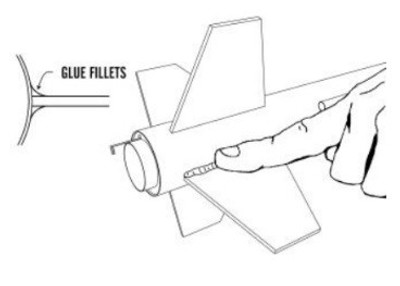A Beginner’s Guide to Fillets in Model Rockets
Posted by Curtis Lee on on 22nd Sep 2023
Maybe you’re building your first rocket. Or perhaps you’ve already built a few. Either way, you might have heard or read about fillets. But what are fillets and why should you use them? In this blog post, we’ll address both those questions as well as provide some basic information on how to do fillets in model rockets.
What Are Fillets?
A fillet (pronounced with the “T” at the end) is a bead of glue that’s applied to the angle where two parts meet. In model rocketry, fillets are most commonly used where the:
Fins attach to the main body tube (Figure 1);
Launch lug attaches to the main body tube (Figure 2); and
Centering rings attach to the motor mount tube (Figure 3).
Figure
1:  Figure
2:
Figure
2: 
Figure
3: 
Fillets can sometimes be found in other parts of the rockets, especially in more advanced rockets. But for the purpose of this blog post, we’ll stick to the types of fillets most commonly found in lower-powered and beginner rockets.
Why Have Fillets?
There are two main reasons to use fillets. First, it’s to add strength to glue joints. Second, it’s to improve the aerodynamics of the model rocket. Specifically, fillets can reduce the rocket’s interference drag.
How to Do Fillets in Model Rockets
Fillets are actually pretty easy to do. The hard part is making them look perfect. When using fillets with fins, you apply a bead of glue to the angle area where the fin connects to the main body tube (Figure 4). Next, take your finger and drag it across the bead of glue (See Figure 5) to make a nice and smooth glue joint (See Figure 6).
Figure
4:  Figure
5:
Figure
5: 
Figure
6: 
When creating fillets where the centering rings connect to the motor mount tube, you follow the same steps. But you don’t have to be as careful to make the joint look good, as you’re using fillets for added strength, not improved aerodynamics or appearance.
After the glue is dry (it will shrink if you used white or wood glue), repeat until the desired fillet size is obtained.
If you’re adding fillets to your fins just to make the joint stronger, one or two fillet layers should be enough. It’s when you want your rocket to look as good as possible and/or fly as high as possible, that you typically need to add multiple fillet layers. But not too much, as the added weight will negate the improved drag characteristics of your rocket.
How to Make Your Launch Lug and Fin Fillets Look Better
Creating nice fillets takes practice, but here are some tips to get better results.
- To get a smoother finish when using white or wood glue, use a damp finger to smooth the fillet.
- Hold the bottle of glue upside down for a few minutes before applying glue to help reduce the chance of air bubbles coming out.
- If you get air bubbles after applying the bead of glue, do your best to pop them with a needle or toothpick as quickly as possible. Hopefully, the glue will self-level after you’ve popped the bubble.
- When smoothing the fillet with your finger, start in the middle of the fillet and drag your finger to the ends of the fillet. This will help prevent too much glue from building up on your fingertip and spreading out, requiring more wiping away of excess glue.
Ways to Make Fillets Easier and Faster
Don’t use too much glue. The amount of glue used in Figure 4 is probably twice as much as necessary, although that much glue was used for that picture so the bead of glue could more readily be seen by the camera. What you didn’t see in Figure 5 was the extra glue that had to be wiped away after a finger was used to smooth the glue bead joint. Using less glue means your fillet will dry faster, too.
Final Notes
This blog post discussed methods and techniques when using wood glue and similar adhesives. Epoxy is another frequently used glue for model rockets, but typically higher-powered ones, where added strength is necessary. We didn’t get into epoxy fillets. However, there will likely be a future blog post discussing advanced fillet methods and tips, which will discuss using epoxy.
Some of you might be wondering about taping the areas around the fins to make a neater fillet. Yes, you can take masking tape or a good-quality modeling tape to create edges that contain the glue. Remove the tape immediately after applying the glue and allow the glue to dry.
After you remove the tape, there will often be a raised edge where the glue touched the tape. This will normally require sanding to smooth out. After it dries, you can paint the rocket with primer and then sand the filleted area smooth. The primer will help fill in the “low” areas and protect the rocket while you sand down the “high” areas of glue.

